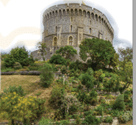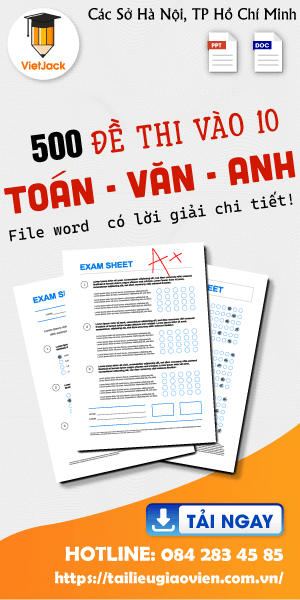Giáo án Tiếng Anh 9 Global Success Unit 4 Getting Started
Giáo án Tiếng Anh 9 Global Success Unit 4 Getting Started
Chỉ từ 300k mua trọn bộ Kế hoạch bài dạy (KHBD) hay Giáo án Tiếng Anh 9 Global Success bản word phong cách hiện đại, trình bày đẹp mắt, dễ dàng chỉnh sửa:
- B1: gửi phí vào tk:
1133836868- CT TNHH DAU TU VA DV GD VIETJACK - Ngân hàng MB (QR) - B2: Nhắn tin tới Zalo VietJack Official - nhấn vào đây để thông báo và nhận đề thi
I. OBJECTIVES
By the end of this lesson, Ss will be able to:
1. Knowledge
- Use the words related to the topic remembering the past
- Gain vocabulary to talk about some historical places.
2. Competences
- Develop communication skills
- Be collaborative and supportive in pair work and team work
3. Personal qualities
- Actively participate in class
- Develop self-study skills
II. MATERIALS
- Grade 9 textbook, Unit 4, Getting started
- Computer connected to the Internet
- Projector / TV
- hoclieu.vn
Language analysis
Form |
Pronunciation |
Meaning |
Vietnamese equivalent |
1. complex (n) |
/ˈkɒmpleks/ |
involving a lot of different but related parts . |
khu phức hợp, quần thể |
2. religious (adj) |
/rɪˈlɪdʒəs/ |
relating to, or involved with religion, or living and worshiping according to the beliefs of a particular religion. |
(thuộc) tôn giáo |
3. monument (n) |
/ˈmɒnjumənt/ |
a structure or building that is built to honour a special person or event. |
tượng đài |
4. magnificent (adj) |
/mæɡˈnɪf.ɪ.sənt/ |
very good, beautiful, or deserving to be admired. |
tráng lệ |
5. preserve (v) |
/prɪˈzɜːv/ |
to keep something as it is. |
bảo tồn |
6. heritage (n) |
/ˈher.ɪ.tɪdʒ/ |
features belonging to the culture of a particular society, such as traditions, languages, or buildings, that were created in the past and still have historical importance. |
di sản |
7. occupy (v) |
/ˈɒkjupaɪ/ |
take control |
chiếm giữ |
8. occupied (adj) |
/ˈɒkjupaɪd/ |
being used by someone or with someone in it. |
có người ở |
9. ancient (adj) |
/ˈeɪnʃənt/ |
of or from a long time ago, having lasted for a very long time. |
cổ đại, lâu đời. |
10. generation (n) |
/ˌdʒenəˈreɪʃn/ |
all the people of about the same age within a society. |
thế hệ |
11. found (v) |
/faʊnd/ |
to bring something into existence. |
thành lập |
Assumption
Anticipated difficulties |
Solutions |
Students may lack experience of group/ teamwork. |
- Encourage students to work in groups so that they can help each other. - Give short, clear instructions and help if necessary. |
III. PROCEDURES
1. WARM-UP (5 mins)
a. Objectives:
- To activate students’ knowledge on the topic of the unit.
- To lead in to the unit.
b. Content:
- Think!
- Memory lane
c. Expected outcomes:
- Students can answer some questions of the teacher about school
d. Organisation:
TEACHER’S ACTIVITIES |
STUDENTS’ ACTIVITIES |
CONTENTS |
|
Option 1: Think! - Begin the lesson by reviewing the content covered in Unit 3. T may ask some questions. - Thentell Ss that they are going to learn about the topic Remembering the past in this unit. – Ask Ss to open their books. Draw their attention to the THIS UNIT INCLUDES box and introduce what they are going to learn in this unit. |
- Listen and follow instruction - Answer the questions |
Questions: - Do you care about healthy living? - What do you often do to keep fit? - What did your parents / grandparents do to keep fit / to keep themselves healthy? - What do you know about your grandparents’ lifestyle (their clothes / cooking / eating habits, …)? Suggested answers: - Students own answer |
|
Option 2: Memory Lane - Ask ss to close their eyes and imagine themselves walking down a memory lane. - Ask ss to share one of their memories with the class. - Write the words Remembering the past on the board and lead in the unit. |
- Listen and follow direction |
- What memories do you see? - Are they happy or sad? - What do you smell? - What do you hear? |
e. Assessment
- T checks ss’ answers and gives feedback.
2. ACTIVITY 1: PRESENTATION (7 mins)
a. Objectives:
- To provide students with vocabulary.
- To help students be well-prepared for the listening and reading tasks.
b. Content:
- Vocabulary pre-teaching
c. Expected outcomes:
- Students can identify some new words about historical place
d. Organisation
TEACHER’S ACTIVITIES |
STUDENTS’ ACTIVITIES |
CONTENTS |
|
Vocabulary pre-teaching - Teacher introduces the vocabulary. - Teacher explains the meaning of the new vocabulary by showing pictures or giving explanations |
- Students guess the meaning of words. |
New words: 1. complex (n) 2. religious (adj) 3. monument (n) 4. magnificent (adj) 5. preserve (v) 6. heritage (n) 7. occupy (v) 8. occupied (adj) 9. ancient (adj) 10. generation (n) 11. found (v) |
e. Assessment
- Teacher checks students’ pronunciation and gives feedback.
3. ACTIVITY 2: PRACTICE (30 mins)
a. Objectives:
- To help Ss read for specific information about historical place
- To help Ss learn words and phrases related to historical place
- To help students use the words in context.
b. Content:
- Task 1: Listen and read.
- Task 2: Read the conversation again and answer the questions.
- Task 3: Complete each sentence with a word or a phrase from the box.
- Task 4: Look at the pictures and complete the sentences.
c. Expected outcomes:
- Students understand the conversation and topic of the lesson and can complete the tasks successfully
d. Organisation
TEACHER’S ACTIVITIES |
STUDENTS’ ACTIVITIES |
CONTENTS |
Task 1: Listen and read. (7 mins) | ||
|
- Begin by asking Ss some questions. - Set the context for the listening and reading: Ask Ss to look at the title of the conversation and the picture. Ask them some questions like: What do you think they are discussing? - Then ask Ss to look at the title / the picture and guess what the conversation between the teacher and the Ss might be about. - Play the recording one or twice for Ss to listen and read along. Then have some pairs of Ss read the dialogue aloud. - Ask Ss what they are talking about. Now confirm the correct answer. (They are talking about historic uments, build, communal, …) |
- Look at the pictures and answer questions - Listen to the recording. -Read the conversation aloud. |
Questions: What do you see in the picture(s)? What do you know about it / them? The dialogue on page 40 |
................................
................................
................................
Trên đây là nguồn học liệu Giáo án Tiếng Anh 9 Global Success miễn phí của NXB Giáo dục Việt Nam. Để xem chi tiết, mời bạn tham khảo: Giáo án Tiếng Anh 9 Global Success (NXB Giáo dục)
Để mua Kế hoạch bài dạy (KHBD) hay Giáo án Tiếng Anh 9 năm 2025 mới nhất, mời Thầy/Cô vui lòng xem thử:
Xem thêm các bài soạn Giáo án Tiếng Anh lớp 9 Global Success (bộ sách Kết nối tri thức) chuẩn khác:
Tủ sách VIETJACK luyện thi vào 10 cho 2k11 (2026):
Đã có app VietJack trên điện thoại, giải bài tập SGK, SBT Soạn văn, Văn mẫu, Thi online, Bài giảng....miễn phí. Tải ngay ứng dụng trên Android và iOS.
Loạt bài Giáo án Sinh học lớp 9 mới, chuẩn nhất của chúng tôi được biên soạn bám sát nội dung sgk Sinh học 9 theo chuẩn Giáo án của Bộ GD & ĐT.
Nếu thấy hay, hãy động viên và chia sẻ nhé! Các bình luận không phù hợp với nội quy bình luận trang web sẽ bị cấm bình luận vĩnh viễn.
- Giáo án lớp 9 (các môn học)
- Giáo án điện tử lớp 9 (các môn học)
- Giáo án Toán 9
- Giáo án Ngữ văn 9
- Giáo án Tiếng Anh 9
- Giáo án Khoa học tự nhiên 9
- Giáo án Vật Lí 9
- Giáo án Hóa học 9
- Giáo án Sinh học 9
- Giáo án Địa Lí 9
- Giáo án Lịch Sử 9
- Giáo án GDCD 9
- Giáo án Tin học 9
- Giáo án Công nghệ 9
- Đề thi lớp 9 (các môn học)
- Đề thi Ngữ Văn 9 (có đáp án)
- Đề thi Toán 9 (có đáp án)
- Đề thi Tiếng Anh 9 mới (có đáp án)
- Đề thi Tiếng Anh 9 (có đáp án)
- Đề thi Khoa học tự nhiên 9 (có đáp án)
- Đề thi Lịch Sử và Địa Lí 9 (có đáp án)
- Đề thi GDCD 9 (có đáp án)
- Đề thi Tin học 9 (có đáp án)
- Đề thi Công nghệ 9 (có đáp án)





 Giải bài tập SGK & SBT
Giải bài tập SGK & SBT
 Tài liệu giáo viên
Tài liệu giáo viên
 Sách
Sách
 Khóa học
Khóa học
 Thi online
Thi online
 Hỏi đáp
Hỏi đáp

